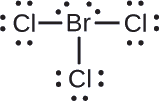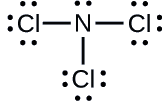Formal Charge Of Nitrous Oxide
7.four: Formal Charges and Resonance
- Page ID
- 112824
↵
- Compute formal charges for atoms in any Lewis construction
- Use formal charges to identify the nigh reasonable Lewis structure for a given molecule
- Explain the concept of resonance and draw Lewis structures representing resonance forms for a given molecule
Previously, we discussed how to write Lewis structures for molecules and polyatomic ions. In some cases, still, at that place is seemingly more ane valid structure for a molecule. Nosotros can apply the concept of formal charges to aid us predict the most appropriate Lewis structure when more than one is reasonable.
Calculating Formal Charge
The formal accuse of an cantlet in a molecule is the hypothetical charge the cantlet would accept if we could redistribute the electrons in the bonds evenly between the atoms. Another way of proverb this is that formal accuse results when nosotros take the number of valence electrons of a neutral cantlet, subtract the nonbonding electrons, and then decrease the number of bonds connected to that atom in the Lewis structure.
Thus, we calculate formal charge as follows:
\[\textrm{formal accuse = # valence shell electrons (free cantlet) − # lone pair electrons − }\dfrac{1}{ii}\textrm{ # bonding electrons} \nonumber \]
We can double-cheque formal charge calculations by determining the sum of the formal charges for the whole structure. The sum of the formal charges of all atoms in a molecule must be zero; the sum of the formal charges in an ion should equal the charge of the ion.
Nosotros must remember that the formal charge calculated for an atom is not the actual charge of the atom in the molecule. Formal accuse is only a useful bookkeeping process; it does not bespeak the presence of actual charges.
Assign formal charges to each atom in the interhalogen ion \(\ce{ICl4-}\).
Southolution
Nosotros divide the bonding electron pairs equally for all \(\ce{I–Cl}\) bonds:

We assign lone pairs of electrons to their atoms. Each Cl cantlet now has 7 electrons assigned to it, and the I atom has eight.
Subtract this number from the number of valence electrons for the neutral cantlet:
- I: seven – 8 = –1
- Cl: 7 – 7 = 0
The sum of the formal charges of all the atoms equals –i, which is identical to the charge of the ion (–one).
Summate the formal accuse for each cantlet in the carbon monoxide molecule:

- Answer
-
C −ane, O +ane
Assign formal charges to each cantlet in the interhalogen molecule \(\ce{BrCl3}\).
Solution
Assign one of the electrons in each Br–Cl bond to the Br atom and one to the Cl cantlet in that bail:

Assign the lone pairs to their cantlet. Now each Cl cantlet has 7 electrons and the Br atom has vii electrons.
Decrease this number from the number of valence electrons for the neutral atom. This gives the formal charge:
- Br: 7 – 7 = 0
- Cl: seven – vii = 0
All atoms in \(\ce{BrCl3}\) take a formal charge of zero, and the sum of the formal charges totals zero, as it must in a neutral molecule.
Make up one's mind the formal charge for each cantlet in \(\ce{NCl3}\).
- Answer
-
N: 0; all three Cl atoms: 0

Using Formal Charge to Predict Molecular Construction
The arrangement of atoms in a molecule or ion is called its molecular structure. In many cases, following the steps for writing Lewis structures may lead to more than ane possible molecular structure—unlike multiple bond and lone-pair electron placements or unlike arrangements of atoms, for instance. A few guidelines involving formal accuse tin be helpful in deciding which of the possible structures is most likely for a particular molecule or ion.
- A molecular structure in which all formal charges are zero is preferable to one in which some formal charges are non zip.
- If the Lewis structure must have nonzero formal charges, the organization with the smallest nonzero formal charges is preferable.
- Lewis structures are preferable when adjacent formal charges are zip or of the opposite sign.
- When we must choose among several Lewis structures with similar distributions of formal charges, the structure with the negative formal charges on the more electronegative atoms is preferable.
To see how these guidelines apply, let u.s.a. consider some possible structures for carbon dioxide, \(\ce{CO2}\). We know from our previous discussion that the less electronegative atom typically occupies the primal position, but formal charges allow us to sympathise why this occurs. Nosotros can draw iii possibilities for the structure: carbon in the center and double bonds, carbon in the eye with a unmarried and triple bond, and oxygen in the eye with double bonds:

Comparing the three formal charges, we can definitively identify the structure on the left as preferable because it has simply formal charges of zero (Guideline 1).
As another instance, the thiocyanate ion, an ion formed from a carbon atom, a nitrogen atom, and a sulfur atom, could have three different molecular structures: \(\ce{CNS^{–}}\), \(\ce{NCS^{–}}\), or \(\ce{CSN^{–}}\). The formal charges present in each of these molecular structures can assistance us selection the most likely arrangement of atoms. Possible Lewis structures and the formal charges for each of the three possible structures for the thiocyanate ion are shown hither:

Note that the sum of the formal charges in each case is equal to the charge of the ion (–1). However, the starting time organization of atoms is preferred considering it has the lowest number of atoms with nonzero formal charges (Guideline 2). Also, it places the to the lowest degree electronegative cantlet in the center, and the negative accuse on the more electronegative element (Guideline 4).
Nitrous oxide, N2O, unremarkably known as laughing gas, is used as an anesthetic in minor surgeries, such as the routine extraction of wisdom teeth. Which is the likely structure for nitrous oxide?

Solution Determining formal accuse yields the following:

The structure with a last oxygen atom best satisfies the criteria for the most stable distribution of formal charge:

The number of atoms with formal charges are minimized (Guideline 2), and at that place is no formal accuse larger than one (Guideline 2). This is again consistent with the preference for having the less electronegative cantlet in the primal position.
Which is the nigh likely molecular construction for the nitrite (\(\ce{NO2-}\)) ion?

- Answer
-
\(\ce{ONO^{–}}\)
Resonance
You may have noticed that the nitrite anion in Case \(\PageIndex{iii}\) can have two possible structures with the atoms in the aforementioned positions. The electrons involved in the North–O double bail, however, are in different positions:

If nitrite ions do indeed incorporate a single and a double bond, we would expect for the two bail lengths to be different. A double bond betwixt two atoms is shorter (and stronger) than a single bond between the same two atoms. Experiments show, however, that both Northward–O bonds in \(\ce{NO2-}\) have the same strength and length, and are identical in all other properties.
It is not possible to write a single Lewis structure for \(\ce{NO2-}\) in which nitrogen has an octet and both bonds are equivalent. Instead, nosotros use the concept of resonance: if ii or more Lewis structures with the same organization of atoms can be written for a molecule or ion, the actual distribution of electrons is an boilerplate of that shown by the various Lewis structures. The actual distribution of electrons in each of the nitrogen-oxygen bonds in \(\ce{NO2-}\) is the average of a double bond and a single bond. We call the individual Lewis structures resonance forms. The actual electronic structure of the molecule (the average of the resonance forms) is called a resonance hybrid of the individual resonance forms. A double-headed arrow between Lewis structures indicates that they are resonance forms. Thus, the electronic construction of the \(\ce{NO2-}\) ion is shown as:

We should remember that a molecule described as a resonance hybrid never possesses an electronic structure described by either resonance form. It does not fluctuate between resonance forms; rather, the actual electronic structure is e'er the average of that shown by all resonance forms. George Wheland, one of the pioneers of resonance theory, used a historical analogy to describe the human relationship between resonance forms and resonance hybrids. A medieval traveler, having never before seen a rhinoceros, described it as a hybrid of a dragon and a unicorn because it had many backdrop in common with both. Simply as a rhinoceros is neither a dragon sometimes nor a unicorn at other times, a resonance hybrid is neither of its resonance forms at any given time. Like a rhinoceros, it is a real entity that experimental evidence has shown to exist. Information technology has some characteristics in mutual with its resonance forms, but the resonance forms themselves are convenient, imaginary images (similar the unicorn and the dragon).
The carbonate anion, \(\ce{CO3^2-}\), provides a second example of resonance:

One oxygen atom must have a double bond to carbon to complete the octet on the central atom. All oxygen atoms, notwithstanding, are equivalent, and the double bail could course from any one of the three atoms. This gives rise to three resonance forms of the carbonate ion. Because we can write 3 identical resonance structures, we know that the actual arrangement of electrons in the carbonate ion is the average of the iii structures. Again, experiments show that all three C–O bonds are exactly the same.
Summary
In a Lewis structure, formal charges can exist assigned to each cantlet past treating each bond as if one-half of the electrons are assigned to each atom. These hypothetical formal charges are a guide to determining the most appropriate Lewis structure. A structure in which the formal charges are every bit shut to zero as possible is preferred. Resonance occurs in cases where two or more Lewis structures with identical arrangements of atoms but unlike distributions of electrons can be written. The actual distribution of electrons (the resonance hybrid) is an average of the distribution indicated by the individual Lewis structures (the resonance forms).
Central Equations
- \(\textrm{formal charge = # valence shell electrons (gratis atom) − # one pair electrons − }\dfrac{1}{ii}\textrm{ # bonding electrons}\)
Glossary
- formal charge
- charge that would outcome on an atom by taking the number of valence electrons on the neutral atom and subtracting the nonbonding electrons and the number of bonds (one-half of the bonding electrons)
- molecular construction
- system of atoms in a molecule or ion
- resonance
- situation in which ane Lewis construction is insufficient to depict the bonding in a molecule and the average of multiple structures is observed
- resonance forms
- two or more Lewis structures that take the same system of atoms merely unlike arrangements of electrons
- resonance hybrid
- average of the resonance forms shown past the individual Lewis structures
Formal Charge Of Nitrous Oxide,
Source: https://chem.libretexts.org/Courses/Louisville_Collegiate_School/General_Chemistry/LibreTexts%2F%2FLouisville_Collegiate_School%2F%2FChapters%2F%2F07:_Chemical_Bonding_and_Molecular_Geometry/LibreTexts%2F%2FLouisville_Collegiate_School%2F%2FChapters%2F%2F07:_Chemical_Bonding_and_Molecular_Geometry%2F%2F7.4:_Formal_Charges_and_Resonance
Posted by: stanfordparrall.blogspot.com


0 Response to "Formal Charge Of Nitrous Oxide"
Post a Comment